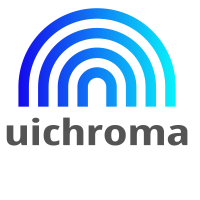
Color vocabulary
If want to use color effectively in your designs, you’ll need to know a few color concepts and terms.
Hue
The term hue and color do not point to the same thing. First, we should understand that term 'color' is a general term that people use to dub all the hues, tints, and tones. On the other hand, a hue is exactly the thing we mean asking “what color is it?”. Basically, it is a family of twelve pure and bold colors presented on the color wheel. A hue serves as a basic material that can be transformed in three different ways – tinting, shading, and toning. They are easy to distinguish. A tint is created by mixing a hue with white, while a shade is a mix of a hue and black. Toning is a more delicate process because it requires adding both black and white the reason why the results may seem more natural than shades and tints.
Chroma
Chroma refers to the purity of a color. A hue with high chroma has no black, white, or gray added to it. Conversely, adding white, black, or gray reduces its chroma. It’s similar to saturation but not quite the same. Chroma can be thought of as the brightness of a color in comparison to white. In design, avoid using hues that have a similar (but not identical) chroma. Opt instead for hues with chromas that are either exactly the same or at least a few steps away from each other.
Saturation
Saturation describes the intensity of a color. Increasing saturation makes the color richer and darker, while reducing saturation makes it look faded and lighter. When we say “light green or “dark red,” we’re describing changes in saturation.
Value
Value is how light or dark a color is. Lighter colors have higher values — such as yellow having a higher value than a dark green. Black has the lowest value of any hue, and white the highest. This contributes to why the two colors are seen as direct opposites.
Tones
Tones are created when grey is added to a hue. Tones are generally softer than pure hues. Tones are sometimes easier to use in designs. More grey can lend a certain vintage feel to websites. Depending on the hues, they can also add a elegant look.
Intensity
Intensity is the brightness or dullness of a pigment. The stronger, or brighter a color is, the more pigment is present in the paint. The weaker or duller a paint color is, there’s less pigment present.
The color wheel
Color wheel and helps to understand how different colors relate to each other and how they can be merged. The color circle is usually built of primary, secondary and tertiary hues.
Primary color
Primary colors form the basis for all other shades. Humans perceive tradtionally three base hues: (blue, red, yellow), but research has shown that magenta, cyan, and yellow better describe our experience of color.So every other hue we see consists of a combination of these three colors in varying amounts, brightnesses, tints, and shades.
Secondary color
These colors appear by the combination of two primary colors. Since each system has different basic colors, the secondary colors vary too.
Tertiary color
a color that is made by mixing one primary color and an adjacent secondary color; ex. red (primary) and orange(secondary) merged together produce the intermediate color, red-orange.
RGB
RGB color system considers red, blue, and green as primary colors. The system is the basis of all colors used on the screen. The combination of primary colors in equal proportions of this system produces secondary colors which are cyan, magenta and yellow, but you need to remember that the more light you add, the brighter and lighter the color becomes.
Cool, warm and neutral colors
Cool colors are the ones on the green-blue side of the color wheel. They are called cool since they bring the feeling of cold. Warm colors are opposite to the previous due to the warm associations which they possess. Yellow, orange, and red are the hues relating to the warm type. Neutral colors are not part of the color wheel including grey, brown and beige.
Tints and shades
A tint results from adding white to a color, and a shade when you add black. Tints and shades let you create monochrome color schemes by adding varying levels of white and black to a base color.